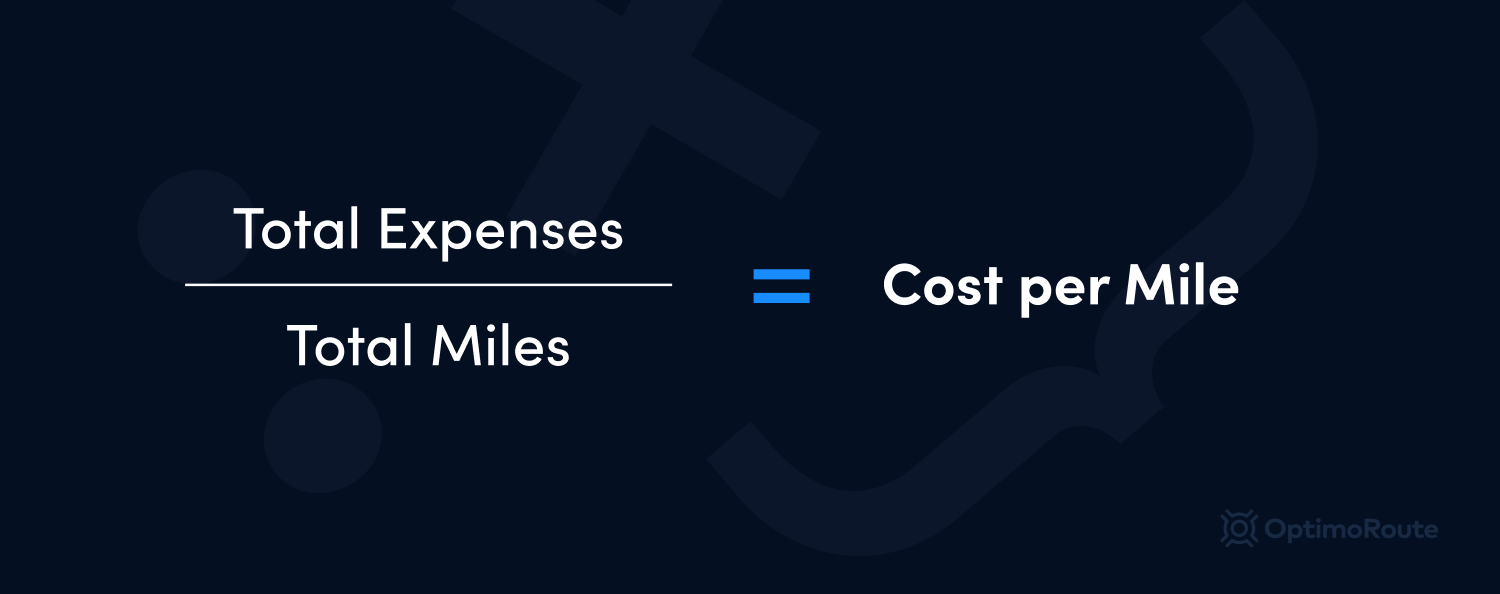How to Calculate Cost per Mile
6 min read

Shipping and delivery are essential to many businesses, but they can be costly expenses. On average, using an in-house fleet for shipping and delivery costs your business $2.80 for every mile on the delivery route. You can’t eliminate this expense entirely from your business, but you can find ways to lower the total cost by breaking down expenses mile by mile.
Calculating cost per mile provides you with valuable insight into the costs of operating your business. Once you’re armed with this information, it’s easier to identify ways to lower your bottom line.
Jump to the part that interests you most:
- 3 Important Considerations for Calculating Cost per Mile
- How to Calculate Cost per Mile
- Cost per Mile Calculator
- The Real Key to Reducing Driving Costs Is Reducing Mileage
- Minimize Drive Time and Save on Fuel With OptimoRoute
3 Important Considerations for Calculating Cost per Mile
In order to calculate cost per mile, you need to know a few key business metrics, such as what your business costs are and how far you drive.
Fixed expenses
You can’t figure out how much you’re spending per mile if you don’t know all of your expenses. The first type is fixed expenses. These are the unchanging expenses of your business. In many businesses, these costs are tracked and monitored by accounting software. They include things like employee salaries, rent for office space, and insurance premiums. These operating costs can add up quickly if your business utilizes self-delivery. On the lowest end, a light box truck will run you at least $25,000. Unless you have the money sitting around, this means truck payments will also be a part of your fixed costs.
Fortunately, these costs are “fixed” and unchanging. So, while it’s still important to monitor them to stay on top of finances, once you know what your fixed expenses are, you won’t have to calculate them again unless there’s a change in your business’s operations.
Variable expenses
Fixed expenses are only half of the equation—variable expenses are the other half. Variable expenses are the business costs that change or “vary” from month to month. This can include things like hourly employee wages and the utilities for your office space. While they may be similar costs from month to month, they won’t be the exact same. As such, you’ll need to develop and implement your own system for tracking these expenses.
Some of the variable costs that relate specifically to your cost per mile include regular vehicle maintenance and repairs, tires, tolls, and licensing for your drivers. Fuel for your vehicles is another important expense, and one that can fluctuate greatly with the average cost of gas.
Miles driven
Just like there are two kinds of expenses to account for in determining cost per mile, there are also two different kinds of miles. You’ll need to track both compensated miles and deadhead miles, or leverage a vehicle tracking system to do it for you. Compensated mileage refers to the miles you drive when you’re en route to make a delivery. Deadhead mileage, on the other hand, refers to the miles you drive after deliveries have been completed and the truck is empty. Sometimes called “empty miles,” this typically isn’t being paid for by a customer as part of the shipping and delivery fee but rather is an unavoidable cost to trucking companies that can lead to additional wear and tear on a vehicle.
How to Calculate Cost per Mile
Cost per mile is an important business metric that will help you assess your organization’s financial health. It’s important to use accurate data when calculating cost per mile to ensure error-free bookkeeping.
1. Determine your mileage over a given time period
Begin by selecting a timeframe for your calculations. If this is your first time calculating your cost per mile, then consider picking a shorter time period (like a single day or week) so that you’ll have smaller figures to work with and fewer data to collect. After this first time, you’ll want to pick a longer timeframe that makes sense for your business and is aligned with how you track other business metrics. For some businesses, this means monthly tracking, while for other businesses, it may be quarterly or semi-annually. Then, track the number of miles driven during this time period.
You likely already have a system for tracking your mileage to receive reimbursements from the IRS. If you don’t, you can use software to track your mileage or calculate it manually by checking your odometer readings and creating a physical log.
2. List out each expense
Track your expenses using the same time period you selected for tracking your mileage. You can do this by creating a list of each of your fixed costs for the time period. Then, add up those expenses to determine the total cost of your fixed expenses. Follow this exact same process for your variable expenses. Then, add your total fixed and variable expenses to calculate your total expenses.
For example, say you pay $400 to rent an office space each month, $100 on insurance, and $500 in employee salaries. You also spent $200 on gas, $100 for utilities, and $50 in tolls this month. Based on these figures, your fixed expenses for the month are $1,000, and your variable monthly costs are $350. This means that your total expenses for the month are $1,350.
3. Divide your expenses by mileage
Calculating cost per mile becomes a simple equation once you know your mileage and total expenses. Divide your total expenses by the total number of miles driven, and the result is your cost per mile. For example, the USPS drives 1.2 billion miles every year, with annual costs totaling $82.2 billion. This means that it costs the USPS $68.50 for every mile driven on mail routes each year.
Cost per Mile Calculator

To avoid the math equation for determining your cost per mile, you can use the calculator we’ve provided below. You can also use this calculator as a safeguard to check your math if you’ve done the cost per mile calculations manually.
The Real Key to Reducing Driving Costs Is Reducing Mileage
You can’t eliminate—or even reduce—many of the operating expenses that impact your cost per mile. Fortunately, you don’t need to. Fuel is the second-largest cost for trucking businesses, and with truckers driving an average of more than 600 miles each day, reducing mileage is the best method for lowering your fuel costs.
You can reduce your mileage by training drivers on efficient driving tactics to encourage money-saving habits. Unfortunately, this won’t lead to any meaningful reduction in your cost per mile. Optimizing your routes will help you cut down on mileage by guaranteeing you’re always taking the most direct route. Consequently, you’ll also be spending less on gas for your fleet, making fuel management a no-brainer.
Minimize Drive Time and Save on Fuel With OptimoRoute
Route optimization requires you to consider a variety of factors, including every individual stop on your route, your vehicle payload capacity, when a customer is available for deliveries to be completed, and standard traffic conditions throughout the day, just to name a few. If you manage an entire fleet, you’ll need to consider these factors for every vehicle in your fleet to plan multiple routes. This sounds like a lot of work—and it is. Fortunately, you can implement a route optimization software like OptimoRoute to handle the entire process for you.
OptimoRoute automatically plans routes for your entire fleet up to five weeks in advance. All you need to do is upload information on your vehicles, your drivers, and the deliveries. Then OptimoRoute will automatically get to work building routes designed to get your drivers from point A to point B to point C as efficiently as possible, reducing the total number of miles you drive and lowering your fuel costs.
OptimoRoute helps decrease trucking expenses by optimizing routes with features like automated weekly planning and workload balancing, along with API integration.
Try our free 30-day trial to see how OptimoRoute can help lower your cost per mile!
Try OptimoRoute™ for Free
No installation or credit card required


